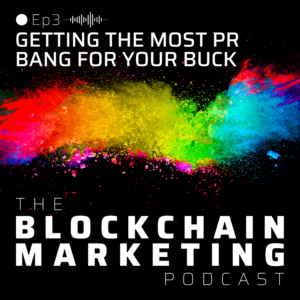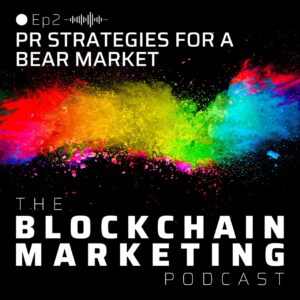In the world of blockchain, high-profile media coverage can make or break a company. However, with a prospect to reach millions of potential investors and users, it’s important to make sure that your PR releases are hitting the right notes with your target audience – provided that they actually reach these groups.
Unfortunately, over the years we’ve noticed that many companies, entrepreneurs, and marketers are pursuing a “set and forget” strategy when it comes to their media coverage. Or in other words, they simply do not feel the need to make any extra efforts beyond posting their PR releases on LinkedIn.
This is a big mistake. If that’s you, your potentially losing out on high-value business partners, customers, or even free PR.
That’s we, Johnathan King and Simon Moser, felt the need to discuss this matter in episode 3 of The Blockchain Marketing Podcast. And if you’re one of the sophisticated folks who prefer reading over listening then don’t worry – this article will summarize everything we discussed.
1. Map out a clear strategy for every single PR story
This may surprise you, but more often than not companies actually don’t have a clear for each individual PR release. While they usually do have an overall PR strategy, they forget about the strategic aspect when it comes to a single PR story, whether that’s a press release, article feature, podcast, or video interview.
Before you’re investing time, money, or other resources, it’s extremely important to think about the target audience, the message you want to convey, and the goals you’re looking to achieve.
Thinking about this will help you select a suitable story to tell, the right tone and language to use in your message, come up with relevant visuals, and prepare appropriate arguments.
In addition to considerations that help you craft a better PR release, you will also need to think about what you’re going to do with the release once it’s published. And that’s exactly what we’re going to talk about next.
Share it on your social media channels and encourage your followers to share it with their networks as well. Reach out to relevant industry publications and influencers to see if they would be interested in featuring your project in an article or interview.
2. Distribute your story
Once you have your strategy in place, it’s time to get your story out there. But just sending it out into the world without a plan won’t do you any good. You need to be strategic and purposeful in your distribution efforts.
The reality is that online traffic to articles, videos, and other content varies heavily. In fact, most articles on Forbes.com (which has 150m monthly readers) don’t get more than 2,000 views – and a great many don’t even reach 1,000. So you’ll be lucky if even one person reading your piece takes action to approach your company because of it.
To get the biggest reach out of your release, the first thing you should do is select the right PR channel for your story. We’ve noticed that many companies are just releasing a press release via PRWeb or Business Wire and be done with it. Ironically, the same people have no clue what the actual purpose of a traditional press release is.
Press releases should be used to summarize a story for journalists, in order to make their jobs easier and incentivize them to report about the story. A secondary target audience might be professional investors. But consumers or retail investors are typically not big readers of press releases.
Therefore, press releases should be usually followed up with earned media coverage to actually reach your target audience. The ideal media outlets and media format highly depends on the strategy, so you will have to think about that carefully.
Once your PR publications are going live, you will need to make use of all the right channels available to you. Social media, email, and press release distribution websites are essential places to start. Select the right social media channels depending on the content and target audience, and craft your posts according to your strategic considerations.
But don’t just stop there. There are plenty of other ways to distribute your release as well. For example, you could consider reaching out to industry influencers and thought leaders who might be interested in your project and ask them to share it in their newsletters or social channels – we will talk about that more thoroughly in the final section. You could also look for relevant online communities and forums where you can share your release and engage with potential customers or partners.
Finally, make sure that all your different marketing assets (website, brochures, pitch decks, etc.) proudly display your PR coverage. But don’t just put the media’s logo on your website or in a press section that no one reads. Instead, use key fragments of the PR release (e.g., positive things that a journalist said about your business) and quote them on your website, blog posts, social media, offline materials, and really anywhere else where it makes sense. If best-selling book authors can do it successfully, why not you?
3. Recycle Old PR Releases for New Content
Are you tired of constantly coming up with new content ideas? Do you feel like you’re running out of steam when it comes to creating fresh content for your blog, social media channels, or email newsletters? If so, you’re not alone. Many businesses struggle with producing quality content on a regular basis.
However, there’s a solution to this problem that’s been right under your nose all along – your old PR releases! Don’t let these valuable pieces of content go to waste. Instead, recycle them and use them as sources of inspiration for new content.
By repurposing your old PR releases, you can save time and resources on creating new content from scratch. Plus, you’ll be able to get more use out of your existing content, which is always a win-win situation.
Feel free to regularly circle back to older media releases and show them to new members of your audience who may have missed them. In other cases, maybe an old topic becomes hot again because of a recent event – which will also allow you to reignite the interest in your releases. Or, if your old PR release was about a company milestone, you could use it as inspiration to write a blog post about the importance of celebrating achievements in the workplace.
Generally, we advise you to naturally mention your articles, interviews, and videos in all communications regularly to continue reaping the benefits for months and even years.
The possibilities are endless when it comes to repurposing your old PR releases. And the best part is, you don’t have to reinvent the wheel every time you need to create new content. By recycling your old content, you can keep your audience engaged and interested without becoming boring in your audience’s eyes.
4. Distribute Your PR Releases via Cold Outreach
As mentioned previously, we highly recommend to send your best PR releases to thought leaders and influencers in the space. However, that’s just the beginning. We’ve experimented a lot with cold outreach PR distributions in recent years and can vouch for their efficiency.
In fact, we recommend reaching out to a broad spectrum of contacts, from thought leaders to entrepreneurs, specialists, and observers in your field. Many of them will even appreciate a simple message on LinkedIn or other social media as long as you don’t come off as too salesy.
So, here are a few great tips from Johnathan to do effective PR cold outreach on LinkedIn:
1. Identify relevant contacts
The first step in any cold outreach campaign is to identify relevant contacts. These are people who can help promote and support your project, such as investors, industry experts, and thought leaders. You can use tools like LinkedIn or Twitter to find these contacts. Look for people who have an interest in your industry or have previously shown an interest in similar projects.
2. Personalize your outreach
Personalization is key to a successful cold outreach campaign. You need to make sure that your outreach is personalized, relevant, and polite. Start by addressing the recipient by their name and explain why you think they might be interested in this feature.
3. Keep it sweet and short
No matter what message you’re sending out, we always recommend keeping your message short and to the point. Remember, the recipient might be receiving a ton of spam messages from slimy salesmen, and you need to capture their attention quickly. Don’t overcomplicate things and provide just enough information to get them interested in your media feature.
4. Stay cool
Finally, provide the link to the published story and offer them to have a chat about it if they’re interested – but don’t bug them with countless follow-ups if they don’t react. This last part is critical to maintain a good brand reputation and keep the doors open for future interactions.
5. Double down on hot stories
When you have a release that’s generating a lot of buzz, it’s crucial to take advantage of the momentum and maximize its reach. One way to do this is by utilizing paid promotion on social media platforms. By investing in targeted advertising, you can ensure that your release is seen by the right people, at the right time.
Another effective strategy is collaborating with influencers in the blockchain space. Influencers have built up a following of people who trust their opinions, and by partnering with them, you can tap into that audience and gain valuable exposure for your release.
A third option would be to prepare follow-up announcements or commentaries that you could forward to other journalists or thought leaders.
The bottom line
Maximizing the reach of your release is just one piece of the puzzle. To truly build a strong brand and gain a competitive advantage in the blockchain world, it’s important to integrate your PR efforts with your overall marketing strategy. This means identifying your target audience, understanding their pain points, and crafting messaging that speaks directly to them.
It also means leveraging all the channels available to you, including social media, email marketing, content marketing, and more. By creating a cohesive and integrated marketing plan, you can ensure that your PR efforts are working in tandem with your other marketing efforts, and that you’re maximizing the impact of every release.



